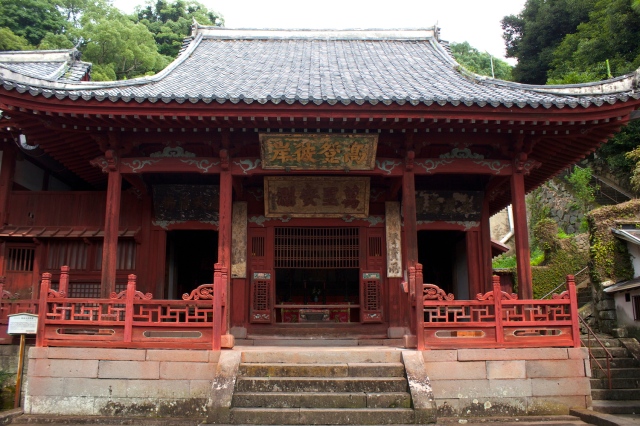Nagasaki has the oldest existing Chinese settlement and community in Japan, consisting of Chinese migrants (from primarily the Fujian province) who crossed over in the early 1600s, during the final years of the Ming Dynasty.
They have assimilated so well as to be considered an integral part of Nagasaki culture, and they’ve contributed one significant dish to Japan’s national cuisine – the chanpon, which is a kind of pork and seafood noodle, originating from the Hokkien word “jia-peng” 吃飯, meaning “eat rice,” literally, but referring to one’s having one’s meal. The most famous of these chanpon restaurants, Shikairo 四海樓 – who actually originated the dish, still stands, just off the former Oura Bund; and still runs a brisk business today.
The architectural heritage of the Chinese in Nagasaki is significant. They contribute the two oldest Zen temples in the city (possibly in Japan) – the Kofukuji 興富寺, built in 1620; and the Sofukuji 崇福寺, built in 1635. Both of which are significant examples of Ming Dynasty architecture outside of China.
The Chinese were originally settled in the Chinese settlement 旧唐人屋敷, established in 1689 as a means of isolating the Chinese from the Japanese, much like Dejima isolated the Dutch. As a result, it is located somewhat adjacent to Dejima – after all, for two centuries, the Dutch and the Chinese were the only foreigners allowed to trade with the city. When the foreign settlements were eventually abolished, the Dutch left, but the Chinese remained.
In the Chinese settlement today remain the trappings of any typical Chinese settlement everywhere – a Temple to the Earth Deity 土神堂 and a temple to the Goddess of Mercy 觀音堂, and one to Confucius 文廟 – but what is unique about this Chinese settlement is that it was clear that the Chinese here, were Hokkien – there is a temple to Mazu 天后堂 (the Goddess of the sea), which the Hokkiens everywhere, including in Singapore worship; and most surprisingly, there is also a Hokkien Huay Kuan 福建會館, or a Hokkien Clan Association, which also exists wherever there are significant Hokkien populations (including in Singapore).
Of course, no Chinese community anywhere will be without its latter-day Chinatown – and Chinatown in Nagasaki is a major attraction for tourists and locals alike, bustling with energy and where some of the best Chinese food can be had.
This gallery takes us to the major sights in Chinese Nagasaki, ending off with a meal at legendary Shikairo, overlooking the Nagasaki harbour, with its ships from all over the world, bringing trade from afar, just like they have done so for almost 500 years.
Historic Chinese Temples in Nagasaki

Entrance to the Koofuki-ji, built in 1620, during the Ming Dynasty, to cater to the religious needs of Chinese merchants who traded in Nagasaki.
The Chinese Settlement, Nagasaki

The Earth God Shrine was originally established in 1691, but it has been renovated and reconstructed multiple times over the years. This is a replica from 1977.

The Temple to the Goddess of Mercy was originally built in 1737, though this version of the temple dates from 1917.

The Tengo Temple – Tengo 天后 is also known as Mazu 媽祖 – was established in 1736 but this version was built in 1906.
Chinatown and Chanpon


















No comments:
Post a Comment